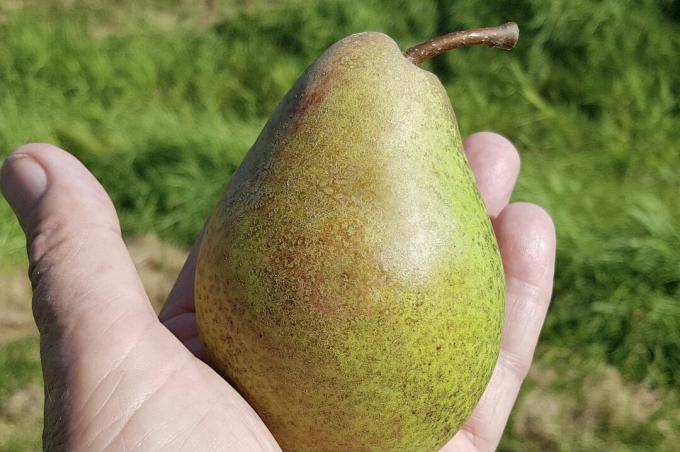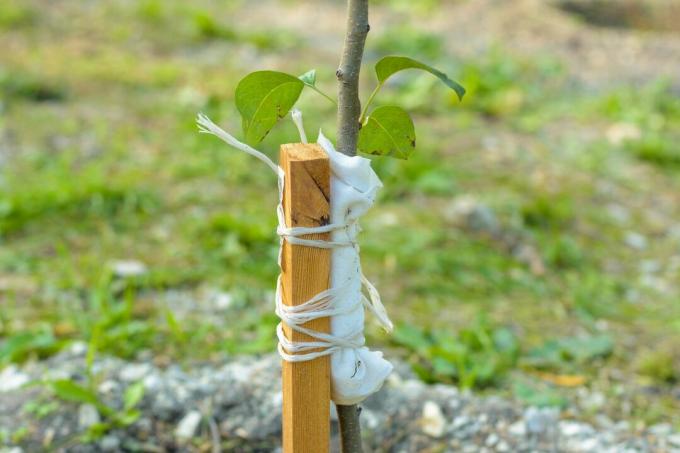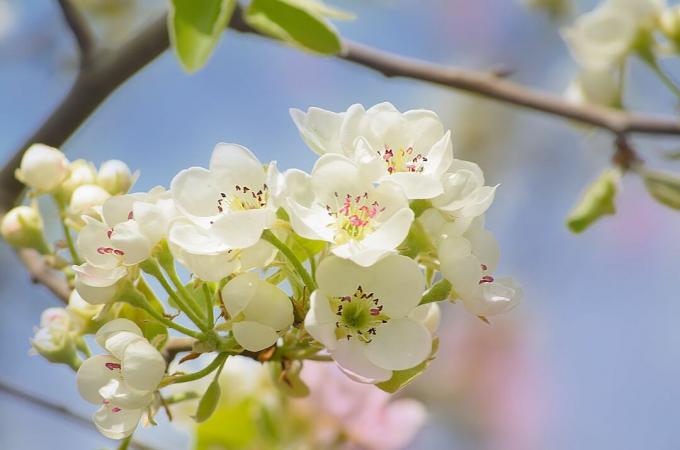The ‘Delicious from Charneux’ is one of the most famous old pear varieties in Central European gardens. We introduce how it got its name and how it can be grown and used.

Pears are sweet and healthy, they contain less acid than apples and are therefore particularly digestible. If you intend to plant a pear tree in your own garden, you will trip over and over again when choosing a variety the ‘Delicious from Charneux’, also called ‘Delicious from Charneux’, ‘Legipont’ and in Northern Germany Mayor's pear ’ will.
"Contents"
- ‘Delicious foods from Charneux’: Profile
- ‘Delicious foods from Charneux’: origin and history
- Taste and properties of the ‘mayor's pear’
- Special features of cultivation and care
- Pear variety ‘Delicious from Charneux’: harvest and use
‘Delicious foods from Charneux’: Profile
| Synonyms | 'Delicious from Charneux', 'Legipont', 'Mayor's Pear' |
| fruit | Medium to large, greenish yellow basic color with an orange covering color |
| taste | Juicy, strong sweet, fine-spicy aroma |
| Yield | High, regular |
| Harvest time | September to October |
| Ripe for enjoyment | October |
| Shelf life | Can be stored at 0 to -1 ° C for about five months |
| growth | Strong |
| climate | Coast to medium altitude, not for frosty areas |
| Diseases and pests | Local for scab, low for tan and stone cell formation |
‘Delicious foods from Charneux’: origin and history
The pear variety ‘Delicious from Charneux’ arose from a random seedling that the Belgian fruit lover M. Legipont at the beginning of the 19th Grown from a seed in his orchard in the mid-19th century. He recognized the qualities of the tree and from 1828 the variety was further spread by the gardener Wilhelm Walker. In 1922, the ‘Delicious from Charneux’ even impressed the German Fruit Growing Society in Germany with its taste and health, so that it was declared a “Reichsobstsorte”. Nowadays the ‘mayor's pear’ is grown in the old country. The pear tree is also very popular in the home gardens of friends of old fruit varieties.
Taste and properties of the ‘mayor's pear’
The ‘mayor's pear’ is medium to large in size. On average, it weighs 150 grams. The pear-shaped fruit is broadly truncated on the calyx and conical on the stem. Overall, however, the shape is variable, so that the sides of the fruit are often uneven, bulged or angular. The calyx pit on the underside of the fruit is flat, narrow to medium-wide and covered with bumps, bumps and folds. In addition, the calyx pit is rusted like a network. The thin skin of the ‘mayor's pear’ is smooth, dry and medium firm.

While the basic color consists of a cloudy yellow-green, which only changes to a cloudy yellow when ripe, the outer color is a mottled, faded or striped cloudy orange. The numerous brown peel points are also typical on the shell. A russeting of the shell occurs only rarely. In warmer locations, the pulp of the ‘Mayor's pear’ is yellowish-white and soft with a buttery, melting, strongly sweet and only slightly sour taste. It contains a fine, spicy, tasty aroma. In colder locations, the pulp is only half-melting.
Special features of cultivation and care
The ‘Delicious from Charneux’ can be planted from the coast to medium altitudes. The old, robust variety tolerates a wide range of locations and climates, so that it is used for different purposes throughout Central Europe. Because the tree is strong, it is often grafted on a base.
Growth & refinement: As a seedling, the ‘Delicious from Charneux’ has a strong growth, especially the central branch is strongly developed. The crown shape is narrow pyramidal. The ‘mayor's pear’ can also be refined to inhibit growth - various documents can be used for this. Only quince rootstocks achieve a comparatively weak growth of the tree, but they are more sensitive to waterlogging and winter frost. Seedling bases are ideal for using the ‘Delicious from Charneux’ as a stately tree, for example in a large garden or on the orchard. They are robust and frost-resistant. Quince supports such as the recommended ‘Quince BA 29’ ensure weak trees that can be raised to small fruit trees that are easier to harvest. However, there is a risk that the quince and the pear will not grow together stably and that the tree will be less durable. Another alternative is the Pyrodwarf® pad, a slow growing pear pad with which pears are well compatible, so that a stable and permanent connection is created.
Location: The ‘Delicious from Charneux’ tolerates many locations. However, a sunny to partially shaded place is suitable for good fruit development. The soil should be nutritious and moist for good growth. Locations at risk of late frost and generally harsh regions are not suitable for this variety because it is susceptible to wood and flower frost.
Tip: The sunnier the location, the more the otherwise green-yellow pears develop red cheeks on the sunny side.

Flowering & fertilization: The white flowers of the ‘Delicious from Charneux’ are formed from April to May and are moderately sensitive to frost. In order to achieve higher yields, the pear needs ‘Delicious Charneux’ pollinators such as ‘Conference‘, ‘Countess of Paris‘, ‘Good Luise‘Or‘ Emperor Alexander ’. At the same time, the tree itself can also serve as a pollinator for other pears.
Yield: The yield of the ‘mayor's pear’ is rather high and regular, as long as it is not unbalanced by severe late frosts or too radical fruit tree prunings.
Diseases and pests: The susceptibility of the tree to diseases and pests varies depending on the rootstock. In general, the pear variety ‘Delicious from Charneux’ is considered robust and easy to care for, it is only susceptible to pear scab.

Pear variety ‘Delicious from Charneux’: harvest and use
The harvest time for the ‘Delicious from Charneux’ is from September to mid-October. The ‘mayor's pear’ reaches its peak in taste in mid-October, when the bowl of the The pear changes from yellow-green to yellow - at the latest then all fruits can be harvested at once will. If they are picked too late, they quickly become overripe and the fruit loses its juice.
The large, sweet fruits can be consumed or processed directly as table pears. They are suitable for canning, for compote or for drying. Processing to make juice or schnapps is also recommended. The ‘Delicious from Charneux’ can be stored for about five months at an early harvest at 0 to -1 ° C.
Are you interested in other old types of fruit? Then take a look at our suitable article, the 30 old and well-tried apple varieties introduces.
